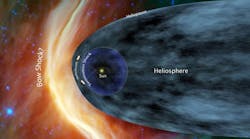As many who read these columns know, NASA has been basking in accolades over their latest scientific coup of landing the Mars Science Laboratory, aka Curiosity, on the Red Planet kicking off 2 years of exploration in search of the building blocks of life. But few remember earlier missions that laid the groundwork for Curiosity.
Today marks the 35th anniversary of the grandest exploration mission of all -- and it's still exploring. Voyager 1 launched September 5, 1977, from Cape Canaveral, followed the trail laid by Voyager 2 that had launched 2 weeks earlier. Now, 35 years later, both crafts are still sending their scientific measurements back to earth, a trip that takes radio waves over 18 hours of travel time from their present positions.
The twin spacecraft were designed to explore Jupiter and Saturn where they made a string of discoveries including active volcanoes on Jupiter's moon Io and the intricacies of Saturn's rings. Voyager 1 continued on its path, but Voyager 2 was commanded to use Saturn's gravity to slingshot it on to Uranus and Neptune, the only spacecraft to reach those planets. They completed their mission through the solar system with such success, that NASA gave them a new mission: an interstellar mission.
The Voyager Interstellar Mission (VIM) extends NASA's exploration of the solar system beyond the neighborhood of the outer planets to the outer limits of the Sun's sphere of influence, known as the heliosphere. Both craft are now in an area of space called the heliosheath. Here, interstellar particles impact the solar wind from our sun, forming a skin-like effect of cosmic particles around our entire solar system. Data recently sent back shows Voyager 1 may be entering the heliopause, the point where the solar and interstellar winds meet. The width of the heliopause is unknown, something scientists hope the Voyagers will help them measure. Current thought is that it will only take a few years to transit. Once through, the Voyagers will become the first man-made objects to travel in the space between the stars. It's hoped this will happen before 2020, the year the crafts run out of the hydrazine fuel that controls attitude and provides electrical power through fuel cells.
The technology of the Voyagers dates from the early 70's. For example, there are six computers total on each craft, two each of three different types. Each type controls a specific aspect of Voyager operations: the computer command system, the flight data system, and the attitude and articulation control system. Between them all, they carry a whopping 68 KB of memory! That's not a typo: Kilobytes it is. By comparison, the iPad today is minimally 100,000x more powerful than all of the computers on Voyager combined.
Curiosity may have the spotlight now, but Voyager 1 and 2 are truly going where no man-made craft has gone before.

